Many guitarists, from beginners to seasoned players, often ponder a seemingly simple yet crucial aspect of their technique: how to hold a guitar pick properly. It might seem like a minor detail, but your pick grip significantly impacts your tone, control, and overall playing experience. Just like the question from JT (NJ), even after years of playing, revisiting and refining your pick technique can unlock new levels of musical expression. This guide delves into the essential techniques for holding a guitar pick, helping you discover the grip that best suits your style and enhances your guitar playing journey.
Understanding the Fundamentals of Holding a Guitar Pick
There isn’t one single “correct” way to hold a guitar pick, but understanding the fundamental methods can provide a solid foundation for developing your own comfortable and effective technique. Let’s explore three common approaches:
The ‘O’ Method (Beginner-Friendly)
This is often considered the most versatile and balanced method, offering a good compromise between control and tonal expressiveness. It’s frequently recommended for beginners as it promotes a natural and adaptable grip.
To execute the ‘O’ method:
- Shape: Form an elongated “O” shape with your thumb and index finger.
- Placement: Rest the pick on the side of your index finger’s first knuckle.
- Grip: Securely grip the pick with your thumb, applying pressure towards the index finger. The pick should protrude enough to effectively strike the strings.
This method allows for a degree of flexibility in your grip, making it suitable for various playing styles and techniques, from strumming chords to playing lead lines.
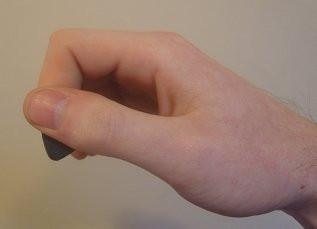 O Method Pick Hold 1
O Method Pick Hold 1
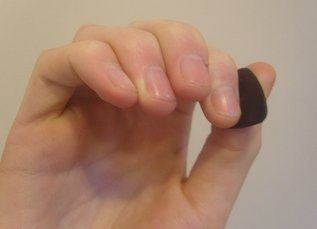 O Method Pick Hold 2
O Method Pick Hold 2
The ‘Pinch’ Method (Flexibility Focus)
The ‘pinch’ method prioritizes flexibility and is often favored by guitarists who frequently strum or use lighter gauge picks. It provides a softer attack and can be beneficial for achieving a smoother, more delicate sound.
To perform the ‘pinch’ method:
- Placement: Instead of the side, use the flat of your index finger.
- Pinch: Pinch the pick between your thumb and the flat of your index finger.
- Light Grip: Maintain a lighter grip, allowing for greater pick flexibility.
This method allows the pick to move more freely, which can be advantageous for strumming complex rhythms and creating a more nuanced dynamic range.
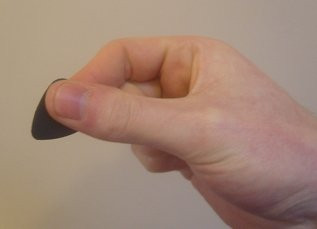 Pinch Method Pick Hold 1
Pinch Method Pick Hold 1
 Pinch Method Pick Hold 2
Pinch Method Pick Hold 2
The ‘Fist’ Method (Power & Heavy Gauges)
The ‘fist’ method, sometimes referred to as the “parallel” method JT mentioned, is often adopted by players who prefer heavier gauge picks and seek a more powerful and direct tone. Bluegrass and heavier rock players often gravitate towards this grip for its attack and volume.
To achieve the ‘fist’ method:
- Curl Index Finger: Curl your index finger so that the top part is roughly parallel to your thumb.
- Placement: Place the pick on the side of your index finger, similar to the ‘O’ method, but with a more curled finger.
- Firm Grip: Grip the pick firmly with your thumb, creating a more rigid and controlled hold.
This grip tends to produce a stronger, louder tone, and it can be particularly effective for single-note runs and achieving a punchier sound. However, as JT noted, it might initially feel less controlled for delicate rhythm playing.
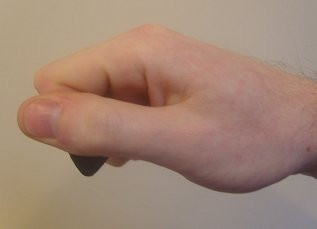 Fist Method Pick Hold 1
Fist Method Pick Hold 1
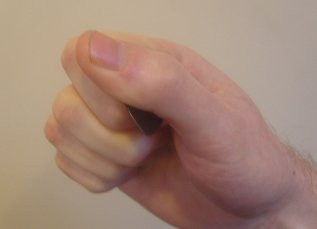 Fist Method Pick Hold 2
Fist Method Pick Hold 2
Finding Your Ideal Pick Grip: Experimentation is Key
The best way to determine the “proper” way to hold a guitar pick for you is through experimentation and mindful practice. Consider these factors as you explore different grips:
Experiment with Pick Gauges
Pick thickness plays a significant role in how a particular grip feels and sounds. Lighter picks (.38mm – .73mm) are more flexible and often work well with strumming and the ‘pinch’ method. Medium picks (.73mm – 1mm) offer a balance of flexibility and stiffness, suitable for the ‘O’ method and versatile playing. Heavier picks (1mm+) provide more attack and are frequently paired with the ‘fist’ method for powerful tones. Try different gauges in combination with various grips to discover what resonates with your playing style.
Consider Your Musical Style
The genre of music you play can influence your pick grip preference. Funk and rhythm-heavy styles might benefit from the flexibility of the ‘pinch’ or ‘O’ method with lighter picks. Blues and rock players might find the ‘O’ or ‘fist’ method with medium to heavy picks provides the desired blend of tone and control. Bluegrass and aggressive styles often favor the power and attack of the ‘fist’ method with heavier picks.
The Importance of Comfort and Control
Ultimately, the most effective pick grip is one that feels comfortable and allows you to maintain control over your playing. A tense or awkward grip can lead to fatigue and hinder your technique. Pay attention to how each method feels in your hand over extended playing sessions. Can you easily transition between different techniques? Do you feel in control of your dynamics and articulation? Comfort and control are paramount for long-term progress.
Avoiding Common Pitfalls
While experimenting is encouraged, be mindful of these common pitfalls when exploring pick grips:
Overthinking and Analysis Paralysis
It’s easy to get caught up in the details and overanalyze every nuance of your pick grip. Remember, the goal is to find a technique that works for you. Don’t get bogged down in endless comparisons or chasing the “perfect” grip. Experiment, choose a method that feels promising, and then focus on practicing and making music.
Copying Others Blindly
While observing and learning from other guitarists is valuable, avoid blindly copying their pick grip without considering your own hand anatomy, playing style, and preferences. What works exceptionally well for one player might not be ideal for another. Use different techniques as starting points, and adapt them to suit your individual needs.
Conclusion: Find Your Grip and Focus on Playing
Mastering How To Properly Hold A Guitar Pick is a journey of exploration and personal discovery. By understanding the fundamental methods – the ‘O’, ‘pinch’, and ‘fist’ – and experimenting with pick gauges and grips in the context of your musical style, you can find a technique that empowers your playing. Don’t be afraid to try different approaches, but once you find a grip that feels comfortable and provides the control and tone you desire, commit to it and focus on what truly matters: making music and enjoying your guitar playing journey.
